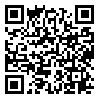Article Type:
Subject:
History
Received: 2025/05/8 | Accepted: 2025/06/7
Received: 2025/05/8 | Accepted: 2025/06/7
Rights and permissions
1- Department of Architecture and Urban Planning, University of Kordestan, Sannadaj, Iran , zanyarsaeedzadeh77@gmail.com
2- Department of Architecture and Urban Planning, Islamic azad University of Shar-e-qods, Teharn, Iran.
3- Department of Architecture and Urban Planning, art university of Esfehan, Esfehan, Iran.
2- Department of Architecture and Urban Planning, Islamic azad University of Shar-e-qods, Teharn, Iran.
3- Department of Architecture and Urban Planning, art university of Esfehan, Esfehan, Iran.
Abstract (1141 Views)
Aims & Backgrounds: One of the emerging approaches to improving the quality of life has been to create a city based on the use of information and communication technology to accelerate access to urban services under the title of smart city. The purpose of the research is to evaluate the feasibility of smart city indicators in District 22 of Tehran.
Methodology: This research is descriptive in terms of internal objectives, content analysis and assessment of the feasibility of the smart city. The data of this research is quantitative. The research method is documentary studies and field survey. The data was collected using a questionnaire with a 5-option Likert scale (very little, little, somewhat, much and too much). Smart city includes six dimensions: smart people, smart living, smart governance, smart economy, smart transportation, and smart environment, and 37 items. Considering the purpose of the research, which is to evaluate the feasibility of smart city indicators, a multiple linear regression test was used to determine the desirability of each indicator using the adjusted coefficient of determination statistics, T-statistic, beta coefficient, and significance level.
Findings: The adjusted coefficient of determination was 0.722, which indicates the suitability of the research model. In fact, this model was able to explain 72.2 percent of the changes in the smart city in district 2. The T-statistic of all variables was obtained at the level of (T>1.96), which indicates the suitability of all these variables in district 2.
Conclusion: The component of smart economy and smart environment are the most desirable and smart living has weak desirability. The component of smart governance and smart people have the highest correlation and smart environment has the lowest correlation with the smart city variable.
Methodology: This research is descriptive in terms of internal objectives, content analysis and assessment of the feasibility of the smart city. The data of this research is quantitative. The research method is documentary studies and field survey. The data was collected using a questionnaire with a 5-option Likert scale (very little, little, somewhat, much and too much). Smart city includes six dimensions: smart people, smart living, smart governance, smart economy, smart transportation, and smart environment, and 37 items. Considering the purpose of the research, which is to evaluate the feasibility of smart city indicators, a multiple linear regression test was used to determine the desirability of each indicator using the adjusted coefficient of determination statistics, T-statistic, beta coefficient, and significance level.
Findings: The adjusted coefficient of determination was 0.722, which indicates the suitability of the research model. In fact, this model was able to explain 72.2 percent of the changes in the smart city in district 2. The T-statistic of all variables was obtained at the level of (T>1.96), which indicates the suitability of all these variables in district 2.
Conclusion: The component of smart economy and smart environment are the most desirable and smart living has weak desirability. The component of smart governance and smart people have the highest correlation and smart environment has the lowest correlation with the smart city variable.
Keywords:







